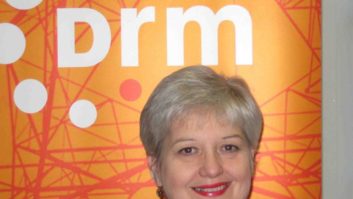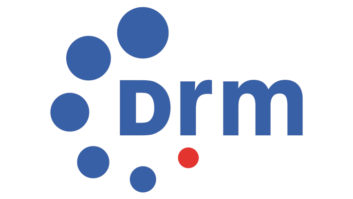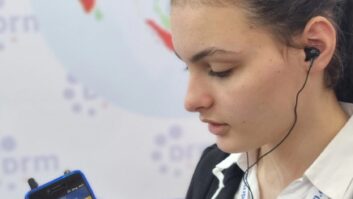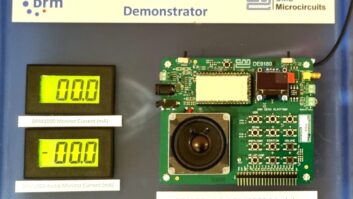(click thumbnail)VATICAN CITY Digital Radio Mondiale trials in Italy are underway.
They’re notable because the broadcasts are the first for the digital technology to involve a private broadcaster, Radio Maria, and also one of the few analog-digital simulcast experiments for DRM, a digital technology for frequencies below 30 MHz.
(click thumbnail)Irte Technician Luciano Candiani, right; Digidia Chief Executive Pascal Olivier, center; and Radio Maria DRM transmitter.
The agreement between World Family of Radio Maria and Italian transmission technology company Irte covers the experimental installations of the Digital Radio Mondiale system in Italy as well as all countries where the Christian broadcasting operation has established Radio Maria stations.
Up until now, DRM testing has been on public-service broadcasters only.
Privately-owned Radio Maria is investing capital and resources in a standard that has yet to really take off.
The three “driving forces” behind the project at Radio Maria are Irte Managing Director Maurizio Martinelli, World Family of Radio Maria President Emanuele Ferrario and Claudio Re, network director at Radio Maria, who oversaw the planning and installation of the DRM system.
A Catholic broadcaster, Radio Maria programs are heard on five continents. Radio Maria is active in more than 40 nations and provides programming in 15 languages; its mission is the preaching of the gospel.
Funding comes entirely from donations and the broadcaster depends primarily on volunteers for its activities.
(click thumbnail)The transmitter mast at Andrate, a site used by various operators that also houses the antenna used by Radio Maria for the DRM trial.
Asymmetrically shaped
The DRM transmissions got under way in June from the Andrate site, located at an altitude of 915 meters, about 50 kilometers from Turin, in the Piedmont region of northwestern Italy.
Radio Maria is simulcasting in AM and DRM, with the AM transmissions receivable at 26.000 MHz and the DRM transmissions at 26.010 MHz. The transmissions go out at a power of 250 W from a 5/8 wavelength antenna.
“To get the most out of the DRM, the AM protection ratio not fully safeguarded, so AM listening is better in a lower sideband or with a software defined radio with a deep rolloff — otherwise, when using normal AM receivers, there can be excessive noise from the adjacent DRM signal,” said Re.
Re also said that, in order to limit disturbance of the AM by the DRM, the lower portion of the DRM radiation pattern is asymmetrical.
The transmission itself is just the last part of a project that involved two important broadcast industry firms: Irte and the French company Digidia.
Irte supplied the know-how, transmitter and antennas and project coordination; Digidia developed the DRM modulation system as specified by Re.
(click thumbnail)From top: Irte 1-kW analog, 250-W digital DRM amplifier, Digidia Soprano exciter, power supply.Accessible costs
The Italian trial is one of the few analog-digital simulcast experiments for DRM.
Another interesting element in the project is the affordability of the solution, officials said, given the accessible costs not only of the Digidia modulator but of the entire transmission chain.
Finally, the trial uses a 26 MHz frequency band that could also constitute an interesting technical solution for local or limited-area transmissions, according to DRM officials.
The transmission chain comprises a Digidia DRM Alto audio content server, a Digidia DRM Soprano exciter and an Irte HF amplifier, which delivers 1 kW in analog and 250 W in DRM.
The initial results have been positive, according to Irte engineers, who say the coverage area is large since there is no excessive interference in the 26 MHz band.
Thanks to the sporadic-E ionospheric propagation, it has been possible to receive and demodulate the Radio Maria DRM signal in Poland, the United Kingdom, Portugal, France and Germany.
Important development
The trial is scheduled to last for at least a year. Though Irte has not given any indication of other projects, the Italian company appears to be banking on the growth of the DRM standard and also of the new DRM+ version, with which it is possible to digitize the VHF range currently used for FM transmissions. DRM+ is still in development.
Until now, practically the only way of receiving DRM signals was to connect a professional receiver to a PC and to demodulate the signal with software. However, at the DRM USA meeting held in May, officials announced that lower-priced, Chinese-made DRM portable receivers will probably be available by the end of this year.
















